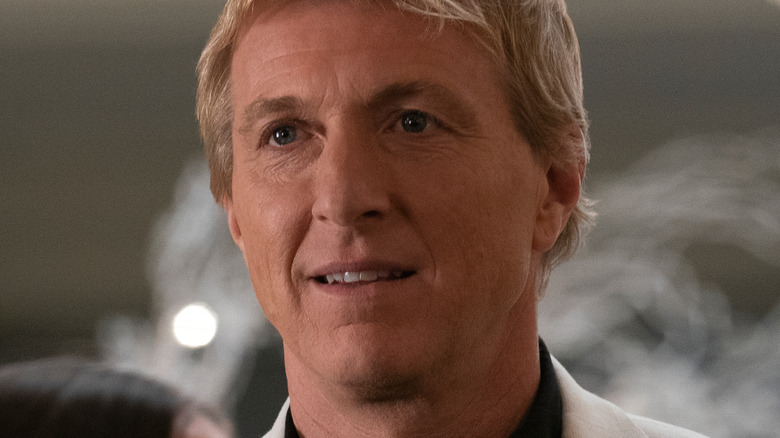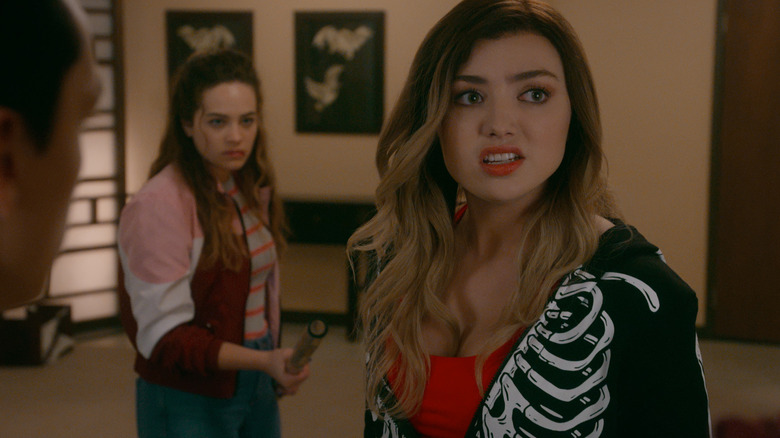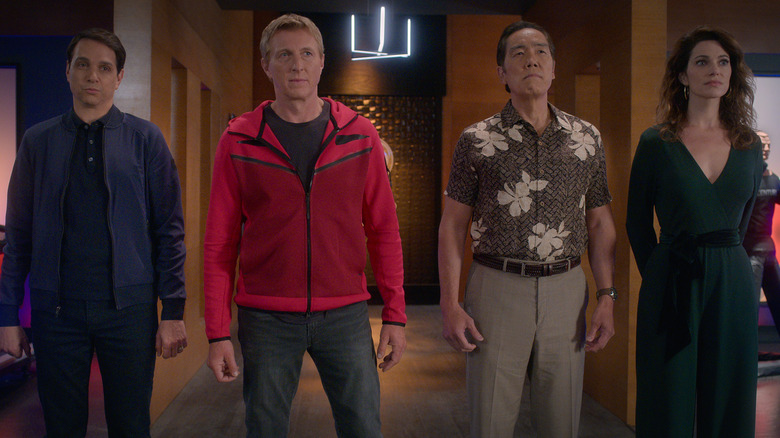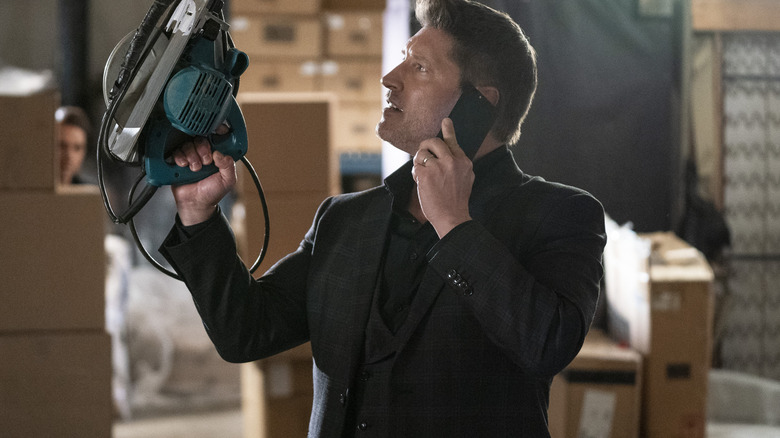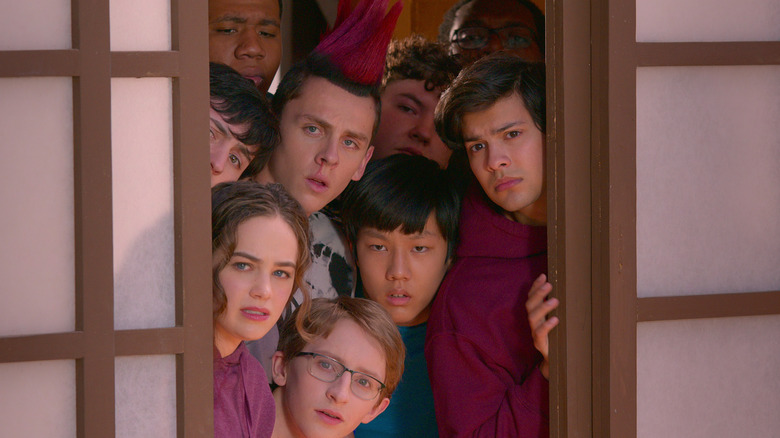How Cobra Kai Figured Out The Recipe To Revive A Tired Old IP
On January 20, Netflix released a video announcing "Cobra Kai" Season 6 and confirming that this will be the final "Cobra Kai" season. Fortunately for the show's fanbase, "Cobra Kai" looks to be ending on a high note. Numerous glowing reviews for "Cobra Kai" Season 5 described it as the series' best, culminating in Season 5 becoming one of the best-reviewed for a Netflix original in the streaming service's history (via Forbes).
In a vacuum, "Cobra Kai" might not seem like smash hit material. After all, the "Karate Kid" franchise that serves as its foundation floundered for the majority of the thirty-plus years between its first film's release and the "Cobra Kai" premiere. While "The Karate Kid" itself is a family-friendly classic, critical and audience reviews alike are middling for its immediate sequel in "The Karate Kid Part II" (via Rotten Tomatoes). Moving forward, while each subsequent entry has its merits, no other "Karate Kid" movie ever garnered anything akin to the acclaim for the first franchise entry.
"Cobra Kai," then, succeeded both because of the popularity of the first "Karate Kid" movie and in spite of the fact that every prior attempt to recapture its particular brand of magic more-or-less failed. In a media landscape constantly rehashing popular IP — for better or, as is more often the case, for worse — "Cobra Kai" stands out as perhaps the premiere example of how to do it right, thanks largely to a complex and intelligent relationship with its source material.
Cobra Kai's treatment of its young cast is key
As is typical for present-day reboots of old IP, the aged legacy characters in "Cobra Kai" are counterbalanced by a brand new crop of youngsters. What sets the young cast of "Cobra Kai" apart from, say, the younger characters in "Ghostbusters: Afterlife" is the depth and attention they're granted.
One of the fiercest rivalries in "Cobra Kai," for instance, is between original "Karate Kid" lead Daniel LaRusso (Ralph Macchio)'s daughter Sam LaRusso (Mary Mouser) and Cobra Kai Dojo wunderkind Tory Nichols (Peyton List), both of whom alternately garner viewers' sympathy and disdain. Mohawked karate prodigy Hawk (Jacob Bertrand) is another standout, as he finds himself at first newly empowered to fight back against his bullies before eventually becoming a bully himself.
While the likes of Daniel and the conniving Cobra Kai founder John Kreese (Martin Kove) are integral to these storylines, the teens' lives are not in service of these legacy characters, but merely complicated by their involvement. Sam, Tory, Hawk, and their fellow young cast members, then, are the raison d'être for "Cobra Kai," which succeeds as a teen karate soap opera first and foremost, and a continuation "The Karate Kid" second. The eventual involvement of say, Terry Silver (Thomas Ian Griffith) works not just because he's a familiar face, but because viewers don't want him to derail the lives of the kids at the show's heart.
Legacy characters in Cobra Kai are both flawed and legendary
Though "Cobra Kai" may not rely fully on its legacy characters as rehashes of old IP often tend to, its approaches to Daniel LaRusso, his high school rival Johnny Lawrence (William Zabka), and some other fixtures of their intertwined childhoods are not just nuanced, but arguably more compelling than how these characters were treated in the franchise's past.
Key to Daniel, Johnny and co. remaining interesting into their adulthood is the way "Cobra Kai" presents them as flawed and capable of growth without diminishing their auras resultant from their elevated positions in "Karate Kid" franchise mythology. In this way, these characters are like both the legendarily powerful Michael Meyers of the "Halloween" revival films and the psychologically tormented Luke Skywalker in "Star Wars: The Last Jedi" — simultaneously iconic and still growing.
In a piece for Polygon, author Dan Sheehan outlines how "Cobra Kai" significantly deepens the rivalry introduced between its two principal characters in "The Karate Kid" by both serving as its continuation and arguing that it's ultimately futile. "Cobra Kai," then, can effectively have its cake and eat it too by providing viewers with the raw satisfaction of Daniel and Johnny continuing their classic battle decades later while interrogating its very existence all the while. Rarely in pop culture do such storied characters continue to grow decades after their introduction as they do in "Cobra Kai."
Cobra Kai embraces change
The manner in which "Cobra Kai" positions its new teen cast at its center while complicating its returning characters is ultimately a function of how "Cobra Kai" is unafraid of change. By comparison, among numerous criticisms of "Star Wars: The Rise of Skywalker" is its reliance on simply reprising high points of past "Star Wars" films in lieu of meaningful forward motion (via RogerEbert.com). Meanwhile, the opening moments of "Cobra Kai" already subvert what viewers should expect from a "Karate Kid" sequel by introducing Johnny Lawrence as its principal character, rather than the first three films' hero in Daniel LaRusso.
Moving forward, "Cobra Kai" continues to embrace this philosophy. For example, Season 5 changes viewers' understanding of Mike Barnes (Sean Kanan), a villain from "The Karate Kid Part III." Rather than returning as an antagonist or adhering to a reformed villain archetype, Mike is an agent of chaos over the course of the season, becoming all the more interesting for his decidedly new and distinct role.
By brazenly altering its source material and molding it into something unique, "Cobra Kai" is treating its viewers as intelligent and capable of welcoming complexity, rather than mindless consumers looking for their next hit of nostalgia. In a Washington Post piece, Daniel W. Drezner argues that retconning is perhaps first and foremost responsible for the show's quality, attributing its sustained success to the glee with which "Cobra Kai" carves out new directions for a previously staid franchise.
When Cobra Kai gets weird, it works
Perhaps the bulk of what makes "Cobra Kai" succeed in ways many of its peers have failed is its intelligent and nuanced approach to existing IP. Also key and maybe even equally important to "Cobra Kai" lasting for six seasons and maintaining the goodwill of its viewer base is that it's a whole lot of fun.
In the "Cobra Kai" universe, 1980s-style karate becomes so popular among a group of Gen Z teenagers that standard high school conflicts over crushes and frayed friendships culminate with fists raised in practiced fighting stances. While blatantly absurd, believability hardly matters in these instances. Rather, thanks to how devotedly "Cobra Kai" builds up its compelling cast of characters, it's easy to simply throw reality out the window and embrace its weird world. Scenes like one in which John Kreese trains the Cobra Kai dojo in an active cement mixer, for example, are among the show's numerous over-the-top highlights, and even retain some dramatic heft against all odds thanks to the care "Cobra Kai" shows for its characters both new and old.
While not always perfect — it features its fair share of painfully unfunny and cloyingly melodramatic moments both — "Cobra Kai" is serious and seriously fun. The inevitable deluge of projects based on beloved properties from the pop cultural past still to come could do well to look toward "Cobra Kai" as a gold standard for the genre.
